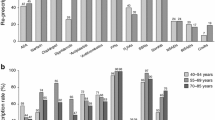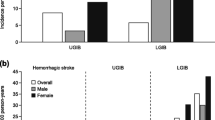Summary
Aim
To test the ability a new Spanish primary care research database (BIFAP) to capture the association between upper gastrointestinal bleeding (UGIB) and NSAIDs and other drugs and compare the results with previous studies.
Methods
We performed a nested case–control study in persons aged 40–90 years old included in the period 2001–2005. Potential cases were selected through a computer search followed by an individual blinded review. Controls matched for age, sex and calendar year were randomly selected. The exposure window was defined as 0–30 days before the index date. Adjusted odds ratios were obtained through unconditional logistic regression models.
Results
In a study cohort of 669,115 subjects (1,576,442 person-years) we retrieved 1,193 valid incident cases. Increased risks were found with current use of NSAIDs (RR = 1.72; 95 %CI: 1.41–2.09), metamizole (1.52; 1.09–2.13), low-dose aspirin (1.74; 1.37–2.21), other antiplatelet drugs (1.73; 1.27–2.36), and oral anticoagulants (2.00; 1.44–2.77). We did not find an increased risk with current use of oral corticosteroids (1.11; 0.66–1.86), SSRIs (1.05; 0.77–1.42), or paracetamol (1.00; 0.82–1.23). Acid-suppressing drugs reduced the risk among users of NSAIDs (0.58; 0.39–0.85), particularly in users with antecedents of peptic ulcer (0.16; 0.05–0.58). We detected a decreasing time-trend in the relative risk and the population attributable proportion associated with NSAIDs over the study period.
Conclusions
The increased risk of UGIB associated with NSAIDs was lower than previously reported, which could partly be explained by methodological differences, but a decreasing burden over time of this drug safety problem is suggested. BIFAP has shown to be a valuable tool for pharmacoepidemiological research.


Similar content being viewed by others
References
De Abajo FJ (2005) Improving pharmacovigilance practice beyond spontaneous reporting. Int J Pharm Med 19:209–218
Schneeweiss S, Avorn J (2005) A review of uses of healthcare utilization databases for epidemiological research on therapeutics. J Clin Epidemiol 58:323–337
Hall GC, Sauer B, Bourke A, Brown JS, Reynolds MW, Casale RL (2012) Guidelines for good database selection and use in pharmacoepidemiology research. Pharmacoepidemiol Drug Saf 21:1–10
Salvador A, Moreno JC, Sonego D, Garcia-Rodriguez LA, de Abajo FJ (2002) El proyecto BIFAP: Base de datos para la Investigación Farmacoepidemiológica en Atención Primaria. Aten Primaria 30:655–661
BIFAP, Base de datos para la investigación farmacoeopidemiológica en atención primaria. Available at: http://www.bifap.org
World Health Organization. International Classification of Primary Care, second edition (ICPC-2). Available at: http://www.who.int/classifications/icd/adaptations/icpc2/en/index.html
WHO Collaborating Centre for Drug Statistics Methodology. ATC/DDD index. Available at: http://www.whocc.no/atc_ddd_index/
García-Rodríguez LA, Barreales Tolosa L (2007) Risk of upper gastrointestinal complication among users of traditional NSAIDs and COXIBs in the general population. Gastroenterology 132:498–506
De Abajo FJ, García-Rodríguez LA (2008) Risk of upper gastrointestinal tract bleeding associated with selective serotonin reuptake inhibitors and venlafaxine therapy. Arch Gen Psychiatry 65:795–803
Walker A (1991) Observation and inference—An introduction to the methods of epidemiology. Epidemiology Resources Inc., Newton Lower Falls
Rothman K (1986) Interaction between causes. Modern epidemiology. Little, Brown and Company, Boston, pp 311–326
Rockhill B, Newman B, Weinberg C (1998) Use and misuse of population attributable fractions. Am J Public Health 88:15–19
Massó E, Patrignani P, Tacconelli S, García-Rodríguez LA (2010) Variability among nonsteroidal anti-inflammatory drugs in risk of upper gastrointestinal bleeding. Arthritis Rheum 62:1592–1601
García-Rodríguez LA, Lin KJ, Hernández-Díaz S, Johansson S (2011) Risk of upper gastrointestinal bleeding with low-dose acetylsalicylic acid alone and in combination with clopidogrel and other medications. Circulation 123:1108–1115
Lanas A, Bajador E, Serrano P, Fuentes J, Carreño S, Guardia J et al (2000) Nitrovasodilators, low-dose aspirin, other non-steroidal anti-inflammatory drugs and the risk of upper gastrointestinal bleeding. N Engl J Med 343:834–839
Laporte JR, Ibañez L, Vidal X, Vendrell L, Leone R (2004) Upper gastrointestinal bleeding associated with the use of NSAIDs—newer vs. older agents. Drug Saf 27:411–420
Lanas A, García-Rodríguez LA, Arroyo MT, Gomollón F, Feu F, González-Pérez A et al (2006) Risk of upper gastrointestinal ulcer bleeding associated with selective cyclo-oxygenase-2 inhibitors, traditional non-aspirin non-steroidal anti-inflammatory drugs, aspirin and combinations. Gut 55:1731–1738
Ulcickas-Yood M, Campbell UB, Rothman KL, Jick SS, Lang J, Wells KE, Jick H, Johnson CC (2007) Using prescription claims data for drugs available over-the counter (OTC). Pharmacoepidemiol Drug Saf 16:961–968
De Abajo FJ, Garcia del Pozo J, del Pino A (2005) Evolución de la utilización de anti-inflamatorios no esteroideos en España desde 1990 a 2003. Aten Primaria 36:424–433
Vergara M, Catalán M, Gisbert JP, Calvet X (2005) Meta-analysis: role of Helicobacter pylori eradication in the prevention of peptic ulcer in NSAID users. Aliment Pharmacol Ther 21:1411–1418
Lanas A et al (2009) Time trends and impact of upper and lower gastrointestinal bleeding and perforation in clinical practice. Am J Gatroenterol 104:1633–1641
Moride Y, Abenhaim L (1994) Evidence of the depletion of susceptibles effect in non-experimental pharmacoepidemiologic research. J Clin Epidemiol 47:731–737
Graham DY, Smith JL, Spjut HJ, Torres E (1988) Gastric adaptation. Studies in humans during continuous aspirin administration. Gastroenterology 95:327–333
Ibáñez L, Vidal X, Vendrell L, Moretti U, Laporte JR, on behalf of the Spanish-Italian Collaborative Group for the Epidemiology of Gastrointestinal Bleeding (2006) Upper gastrointestinal bleeding associated with antiplatelet drugs. Aliment Pharmacol Ther 23:235–242
De Abajo FJ (2011) Effects of selective serotonin reuptake inhibitors on platelet function: mechanisms, clinical outcomes and implications for use in elderly patients. Drugs Aging 28:345–367
García Rodríguez LA, Ruigómez A (1999) Secondary prevention of upper gastrointestinal bleeding associated with maintenance acid-suppressing treatment in patients with peptic ulcer bleed. Epidemiology 10:228–232
Lanas A, García-Rodríguez LA, Arroyo MT, Bujanda L, Gomollón F, Forné M et al (2007) Effect of antisecretory drugs and nitrates on the risk of ulcer bleeding associated with nonsteroidal anti-inflammatory drugs, antiplatelet agents, and anticoagulants. Am J Gastroenterol 102:507–515
Vonkeman HE, Fernandes RW, van der Palen J, van Roon EN, van de Laar MAFJ (2007) Proton-pump inhibitors are associated with a reduced risk for bleeding and perforated gastrodudenal ulcers attributable to non-steroidal anti-inflammatory drugs: a nested case–control study. Arthritis Res Ther 9:R52. doi:10.1186/ar2207
Hippisley-Cox, Coupland C, Logan R (2005) Risk of adverse gastrointestinal outcomes in patients taking cyclo-oxygenase-2 inhibitors or conventional non-steroidal anti-inflammatory drugs: population based nested case–control analysis. BMJ 331:1310–1316
Ibáñez L, Vidal X, Laporte JR (2008) Proton pump inhibitors and risk of upper gastrointestinal bleeding in NSAID users. Am J Gastroenterol 103:2658–2659
Targownik LE, Metge CJ, Leung S et al (2008) The relative efficacies of gastroprotective strategies in chronic users of non-steroidal anti-inflammatory drugs. Gastroenterology 134:937–944
Taha AS, Hudson N, Hawkey CJ et al (1996) Famotidine for the prevention of gastric and duodenal ulcers caused by non-steroidal anti-inflammatory drugs. N Engl J Med 334:1435–1439
Chan FK, Hung LC, Suen BY et al (2002) Celecoxib versus diclofenac and omeprazole in reducing the risk of recurrent ulcer bleeding in patients with arthritis. N Engl J Med 347:2104–2110
Scheiman JM, Yeomans ND, Talley NJ et al (2006) Prevention of ulcers by esomeprazole in at-risk patients using non-selective NSAIDs and COX-2 inhibitors. Am J Gastroenterol 101:701–710
Hawkey CJ (2009) NSAIDs and aspirin: notorious or FAMOUS? Lancet 374:93–94
Acknowledgments
Authors would like to acknowledge the excellent collaboration of general practitioners taking part in BIFAP.
Funding
BIFAP is funded by the Spanish Agency for Medicines and Medical Devices. This specific study was supported by a research grant from Fondo de Investigaciones Sanitarias (# PI040083).
Conflicts of interest
LAGR received unrestricted research grants from AstraZeneca and Bayer.
Author information
Authors and Affiliations
Corresponding author
Electronic supplementary material
Below is the link to the electronic supplementary material.
ESM 1
(DOCX 44 kb)
Rights and permissions
About this article
Cite this article
de Abajo, F.J., Gil, M.J., Bryant, V. et al. Upper gastrointestinal bleeding associated with NSAIDs, other drugs and interactions: a nested case–control study in a new general practice database. Eur J Clin Pharmacol 69, 691–701 (2013). https://doi.org/10.1007/s00228-012-1386-3
Received:
Accepted:
Published:
Issue Date:
DOI: https://doi.org/10.1007/s00228-012-1386-3




